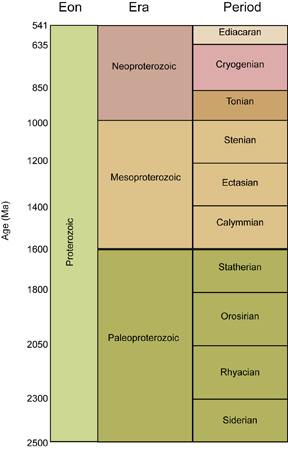


Recently the Mesoproterozoic Era has been divided into the following Periods (with arbitrarily defined boundaries): Calymmian ("covering", after the development of platforms: 1.60 - 1.40 Ga), Ectasian ("extension", both of platforms and of the beginnings of the rifting events: 1.40 - 1.20 Ga), and Stennian ("narrowing", after narrow belts of intense metamorphism and deformation, such as the Grenville Orogeny: 1.20 - 1.00 Ga).
Mesoproterozoic saw high amounts of igneous activity. It may be due to large-scale mantle "superplumes" forming underneath the first continental or supercontinental (not yet observed) granitic masses.
Belt Supergroup: a huge (16 km thick!) sequence of terrestrial mudstones, shallow marine sandstones & limestones & turbidites in western North America, deposited from 1.45 to 0.85 Ga. A huge filled-in down-warped basin of western Laurentia.
During late Mesoproterozoic, assembly of the first well-known supercontinent Rodinia (newer reconstruction; requires online access to Lyell collection):
[Someone has created the Rodinian National Anthem: note, music starts automatically when you launch the page.]
During Neoproterozoic, Rodinia rifts apart around 750 Ma: birth of Pacific Ocean (although generally we call it the Panthalassic Ocean until the break up of Pangaea in the Mesozoic).
From this point onward, western Laurentia never has contact with continental-size masses (although much of the far western part of North America was accreted during the Phanerozoic).
The Pan-African Orogeny (and related orogenies):
To Next Lecture.
To Previous Lecture.
To Syllabus.